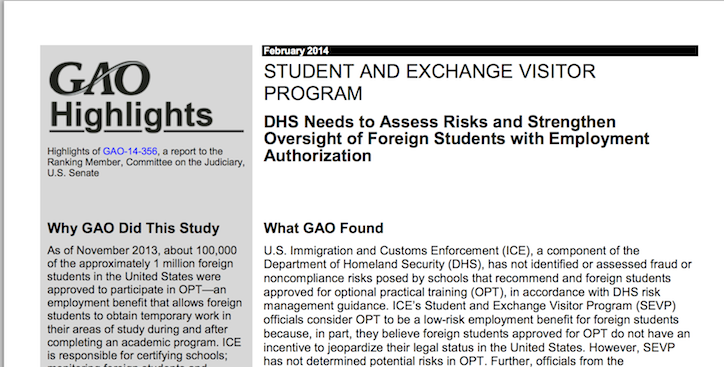The Student and Exchange Visitor Program (SEVP) in the USA has not adequately monitored the 100,000 students working temporarily during or after their studies at a US institution, a report by the Government Accountability Office (GOA) has found. It is calling for immediate action, recommending designated school officials (DSOs) provide more in-depth information to government.
News and business analysis for Professionals in International Education
Have some pie!
Crackdown on USA’s “risky” study-work programme
 Extract from the Government Accountability Office (report) published last month
Extract from the Government Accountability Office (report) published last month According to the report, SEVP, part of US Immigration and Customs Enforcement (ICE), has not properly assessed the risks of fraud posed by allowing students to participate in the optional practical training (OPT) which allows students to work for 12 to 31 months in a sector related to their area study.
“The problems with OPT are extensive and serious. The report not only calls into question the Department’s oversight of the programe but also whether such lack of oversight is a serious national security risk,” said Republic Senator Charles Grassley in a letter to the Homeland Security Secretary Jeh Johnson.
Grassely cited the increase in students approved for OPT from 28,497 in 2008 to 123,328 in 2013 as reason for concern
“The SEVP program, including the OPT program, needs serious leadership that will consider enforcement a top priority and will work diligently to close loopholes and reduce risks associated with it.”
Grassely cited the increase in students approved for OPT from 28,497 in 2008 to 123,328 in 2013 with just 2.6% of applications denied as reason for concern.
He called for a review of the programme to “better understand the use of OPT including who uses it and how students are tracked, determine what weaknesses exist and suggest ways to improve the procedures and policies that govern its administration.”
In the report, GOA claims that students are at risk of overstaying their legal time limit and schools aren’t able to adequately monitor students’ employment after graduation.
SEVP had deemed the programme to be a “low-risk” employment benefit because students wouldn’t have an incentive to jeopardise their visa status.
However, the report claims that “ICE has not consistently collected the information and developed the monitoring mechanisms needed to help ensure foreign students comply with OPT requirements” and advises that ICE require schools put in place more controls.
In part of its analysis of ICE data, GOA found that 38% of student OPT records do not contain an employer’s name or the data when students began working. And 9% of records had authorised employment that exceeded the regulatory limits.
38% of student OPT records do not contain an employer’s name or the data when students began working
Under ICE regulations, OPT is available to foreign students who are enrolled in a college, university, vocational institution in a programme other than English language training. Students must have completed at least one academic scholar year, (or the entire course of study for M visa holders) before they can work part-time while in school or full time on school breaks.
Students may also work full-time for up to 12 months after graduation and can apply for a 17 month extension if they have a degree in a Department of Homeland Security designated STEM (science, technology, engineering and mathematics) programme.
GOA has created a list of recommendation for immediate action. They include SEVP developing guidelines for designated schools officials (DSOs) to determine whether a job is related to a student’s area of study and require DSOs to provide SEVP with information of how they ensure students are in appropriate work.
It also calls for current and graduated students to report to DSOs, and requires DSOs record initial dates of employment, any periods of unemployment and the employers’ name and address in the Student and Exchange Visitor Information System (SEVIS).
Jill Welch, deputy executive director, public policy at NAFSA says the report asks important questions about DHS oversight but doesn’t point out any viable security risks.
“That’s because foreign students are an asset to the United States, not a risk,” she told The PIE News. “Foreign students comprise only 4% of all visitors who enter the United States in nonimmigrant visas status, and yet they are the most heavily tracked throughout their stay. The other 96%, most of whom enter on visitor and business visas, are not monitored at all.”
Welch added that she hoped the report did not fuel further opposition to immigration reform as international students contribute US$24 billion to the US economy and “bring the world to our campuses”.
Still looking? Find by category:



10 Responses to Crackdown on USA’s “risky” study-work programme